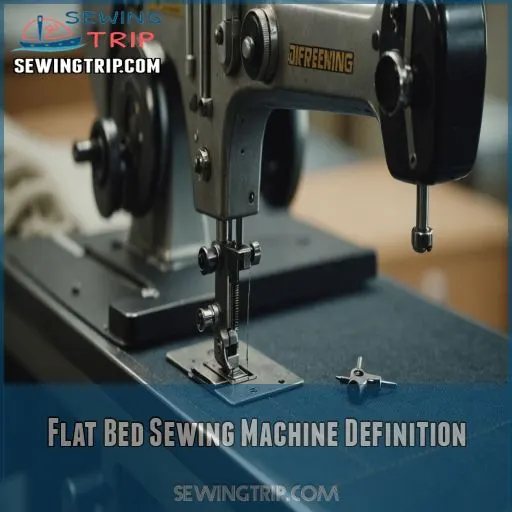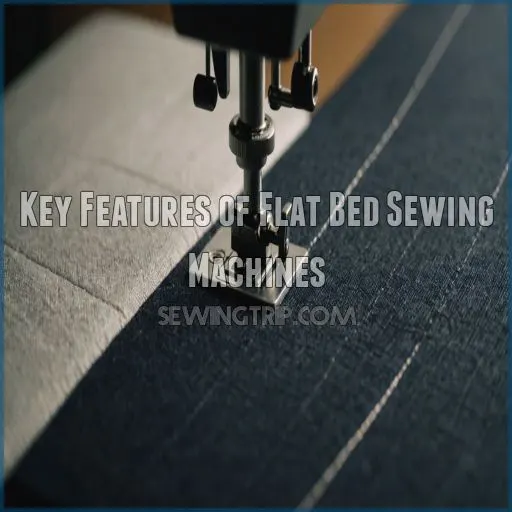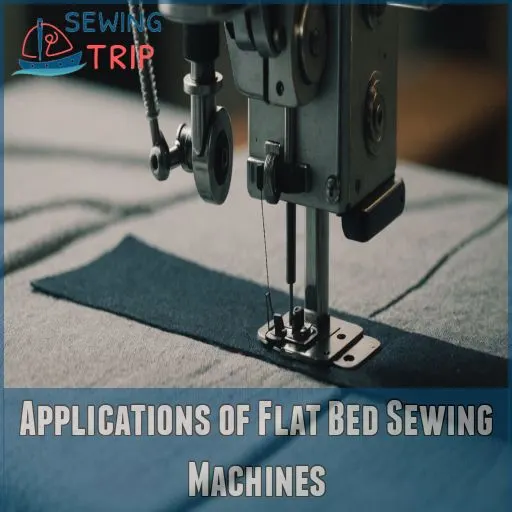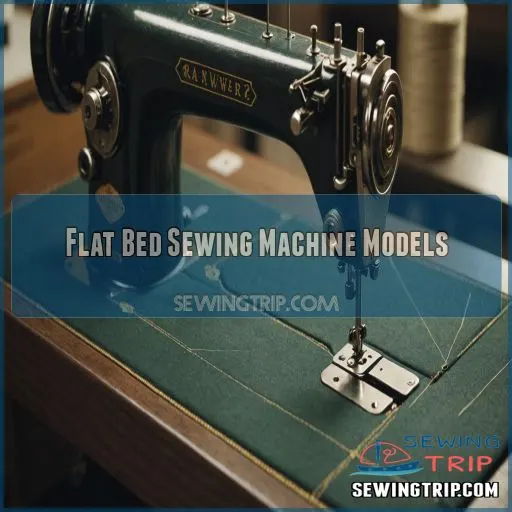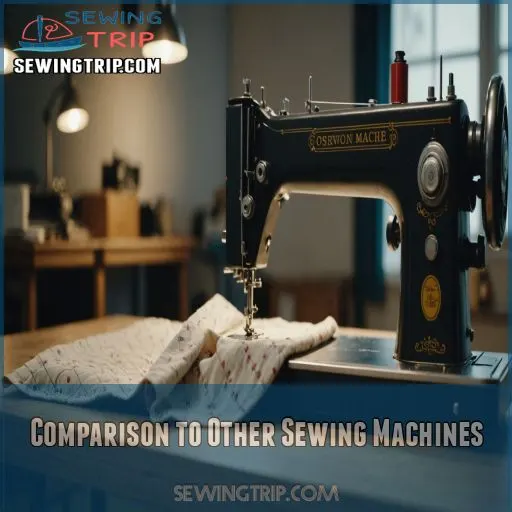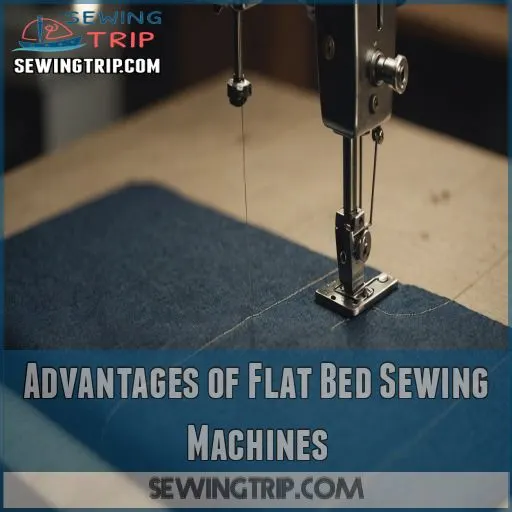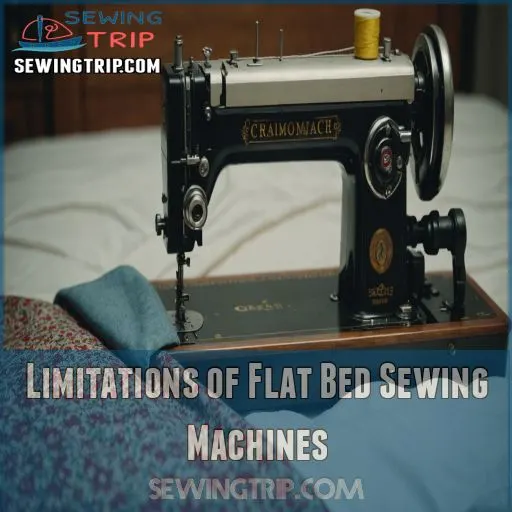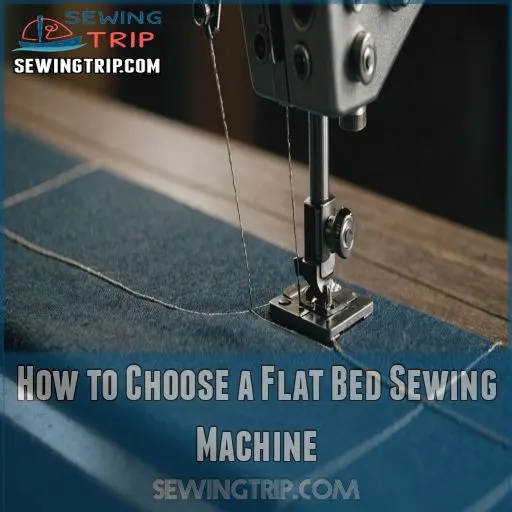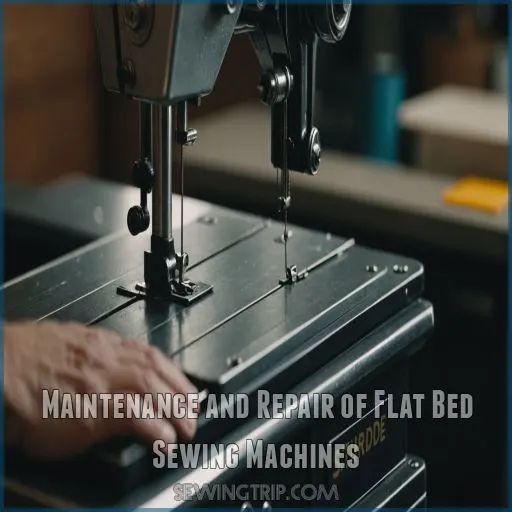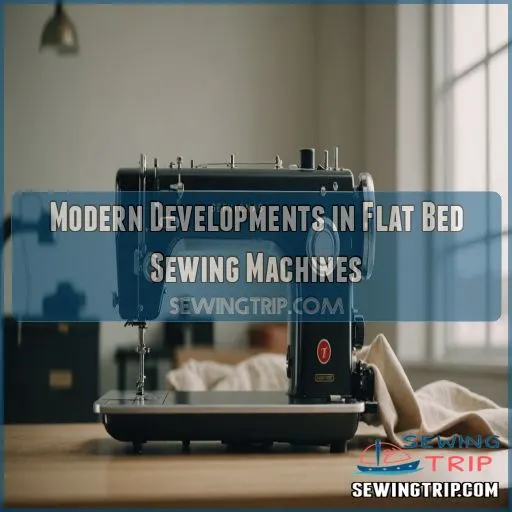This site is supported by our readers. We may earn a commission, at no cost to you, if you purchase through links.
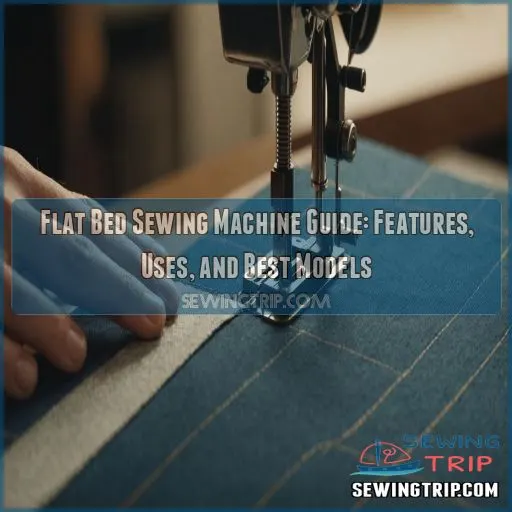
Imagine a sewing machine with a flat surface, perfect for tackling those big, bulky projects like clothes, furniture, and even car interiors.
These machines are built for precision and speed, with features like a vertical-axis hook and unison-feed mechanism that keep your fabric moving smoothly.
Whether you’re a seasoned seamstress or a budding DIY enthusiast, a flat bed sewing machine is a versatile tool that can handle just about any sewing task you throw its way.
Intrigued? Keep reading to discover the ins and outs of these mighty machines!
Table Of Contents
- Key Takeaways
- Flat Bed Sewing Machine Definition
- Key Features of Flat Bed Sewing Machines
- Applications of Flat Bed Sewing Machines
- Flat Bed Sewing Machine Models
- Comparison to Other Sewing Machines
- Advantages of Flat Bed Sewing Machines
- Limitations of Flat Bed Sewing Machines
- How to Choose a Flat Bed Sewing Machine
- Maintenance and Repair of Flat Bed Sewing Machines
- Modern Developments in Flat Bed Sewing Machines
- Frequently Asked Questions (FAQs)
- Conclusion
Key Takeaways
- Flat bed sewing machines are the workhorses of the sewing world, perfect for handling big, bulky projects like clothes, furniture, and car interiors. Their smooth, efficient performance comes from features like the vertical-axis hook and unison-feed mechanism that keep your fabric moving smoothly.
- These machines are a jack-of-all-trades, tackling everything from leather goods and home decor to industrial applications like bag making and automotive upholstery. With their precision and control, you will be sewing like a pro in no time.
- Choosing the right flat bed sewing machine for your needs is key to understanding the differences between mechanical and computerized sewing machines. Whether you are a beginner or a seasoned pro, consider factors like machine type, budget, maintenance, and user-friendliness to find your perfect match.
- Keeping your flat bed sewing machine in tip-top shape is a breeze with regular maintenance. From troubleshooting common issues like needle breakage and thread tension to repairing damaged parts, a little maintenance will ensure your machine runs like new for years to come.
Flat Bed Sewing Machine Definition
When you think of flat bed sewing machines, picture the workhorses of the sewing world ready to tackle a variety of tasks.
They’re designed for sewing flat fabrics like clothes, furniture covers, and even car interiors.
So you’ll be stitching with ease and precision, just like a pro (Source).
Types of Flat Bed Sewing Machines
Flat-bed sewing machines are the bread and butter of sewing, perfect for handling flat fabrics like curtains or garments.
You’ve got choices, from industrial heavyweights to home-friendly models.
Whether you’re tackling denim or delicate fabric, understanding needle sizes and feed mechanisms helps tailor your experience.
Basically, it’s about knowing your machine’s quirks and keeping maintenance tip-top!
Characteristics of Flat Bed Sewing Machines
Flat bed sewing machines are renowned for their smooth, efficient performance.
A spacious, level work surface allows you to easily maneuver bulky fabrics and achieve precise stitching.
The vertical-axis hook and unison-feed mechanism guarantee consistent stitch quality, even on heavy-duty materials.
Plus, the automatic thread trimmer saves time and hassle.
These machines are built to handle a wide range of sewing tasks with speed and precision.
Uses of Flat Bed Sewing Machines
When diving into the world of flat bed sewing machines, you’ll discover they’re a jack-of-all-trades in:
- Leather goods: Perfect for intricate assembly and topstitching seams.
- Home decor: Handles general operations and creation of cushion covers effortlessly.
- Industrial applications: Ideal for bag making and automotive upholstery, offering precision and control.
That’s versatility wrapped in metal!
Key Features of Flat Bed Sewing Machines
When you’re exploring the essential features of flat bed sewing machines, you’ll discover the wonders of the vertical-axis large hook, unison-feed mechanism, and the automatic thread trimmer that make sewing as smooth as sliding on a well-oiled zipper. These features are crucial in industrial sewing machines, as described in detail in this article on industrial sewing machine features.
These features do the heavy lifting, so you don’t have to wrestle with every stitch, letting you focus on creating your masterpiece without breaking a sweat or, worse, a thread!
Vertical-Axis Large Hook
The secret sauce in a flat bed sewing machine is the vertical-axis large hook, which is essential for understanding bobbin winding. This clever hook design improves stitch quality and thread tension control, really important for high-speed sewing machines. Imagine it as the conductor keeping your sewing symphony in harmony.
Ace maintenance with these tips:
| Hook Design | Stitch Quality | Feed Mechanism | Maintenance Tips |
|---|---|---|---|
| Vertical-axis | Improved | Precise | Regular cleaning |
| Large hook | Consistent | Accurate | Lubricate often |
Keep that hook happy, and you’ll sew like a dream!
Unison-Feed Mechanism
You’ll love the unison-feed mechanism on these flat bed sewing machines.
It makes sure your fabric moves smoothly and evenly through the machine, no matter how thick or tricky the material.
Say goodbye to puckered seams and uneven stitches – the unison-feed keeps everything perfectly aligned for professional-looking results every time.
Automatic Thread Trimmer
Stitching success hinges on precision, just like a magician’s sleight of hand! Automatic thread trimmers on flat-bed sewing machines cut sewing time dramatically, snipping excess threads with a flourish, making adjusting thread tension a breeze. Let’s explore:
- Thread trimmer types for every task
- Trimmer benefits that save sanity
- Trimmer maintenance for smooth operations
- Trimmer problems that need troubleshooting
Ensuring effortless sewing without a hitch!
Applications of Flat Bed Sewing Machines
You’ll find flat bed sewing machines are a versatile powerhouse, perfect for crafting everything from stylish apparel to robust car seats and cozy furniture.
Flat bed sewing machines handle delicate fabrics and heavyweight materials with grace and reliability, ensuring your projects come together seamlessly.
Apparel Manufacturing
In apparel manufacturing, using a flat bed sewing machine is like having a trusty sidekick.
It handles garment construction with precision, boosting production efficiency for long seams and controlled top-stitching.
Perfect for sewing with extra width, this machine embraces fabric properties, ensuring two-needle top-stitching operations that meet the latest apparel trends.
It’s your secret weapon in stitching success!
Furniture and Upholstery
Flat bed sewing machines are a godsend for furniture and upholstery projects.
Their powerful unison-feed mechanism and vertical-axis large hook make quick work of thick, stubborn upholstery fabrics.
The roller presser is a game-changer for sewing on small parts like buttons and trims.
And with their feed-off-the-arm design, you can tackle even the bulkiest of soft furnishings.
Automotive Interiors
You know, when you’re jazzed about car seat stitching or leather upholstery, grab a flat bed sewing machine for really good seam quality.
With precise edge recognition, it’s like having a GPS for your needle—finding the right path every time!
Tackling interior design projects? This sewing machine’s diverse features make sure not just durability, but also the control you’ve always dreamed of!
Heavy-Duty Materials
When tackling heavy-duty fabrics like thick leather or reflective stripes, a flat bed sewing machine feels like a trusty sidekick.
It’s built for the hard stuff, making industrial sewing a breeze.
With its robust body design, this machine laughs in the face of thick materials and sewing challenges.
Say goodbye to frustration and hello to precision!
Flat Bed Sewing Machine Models
You’re about to explore some of the best models in flat bed sewing machines, where precision and speed work together like peanut butter and jelly!
From the formidable LU-2800 Series to the nimble LU-1509N Series, these machines are ready to tackle anything you throw at them, turning even the toughest sewing challenge into a piece of cake.
LU-2800 Series
If you’re tackling heavy-duty sewing tasks like car seats, furniture, or cargo belts, the LU-2800 series is a workhorse you’ll love. This semi-dry, unison-feed lockstitch machine boasts a vertical-axis large hook for smooth, efficient stitching on multi-layered materials. Plus, it sports an automatic thread trimmer to save you time. What’s not to love?
- Vertical-axis large hook design
- Semi-dry, unison-feed mechanism
- Automatic thread trimmer
- Ideal for heavy-duty applications
LU-2810ESAL-7
Step up your sewing game with the LU-2810ESAL-7. This flat bed sewing machine is a speed demon, perfect for those driven by efficiency.
Folks rave about its parts, and it doesn’t cost an arm and a leg!
Maintenance is a breeze, like keeping your shoulder flaps in line with edge detection.
Who knew types of sewing machines could offer such control?
LU-2828ESA-7
The LU-2828ESA-7 is your go-to flat bed sewing machine for balancing speed and precision.
Boasting automation features like sleeve clasps and a deft touch with breast pockets, it’s a maestro for reflective strips too.
Maintenance tips? Keep it oiled and clean!
You might shell out a bit upfront, but the cost analysis says it’s worth your while.
LU-1508N, LU-1509N Series
Imagine sewing through the most stubborn fabrics with ease!
The LU-1508N and LU-1509N models are your trusty sidekicks in heavy-duty sewing adventures.
Packed with unison-feed technology and a large hook, they’re designed for precision and strength.
Curious about LU-1508N vs LU-1509N? It’s all about specific features!
Check out reviews and pricing to stitch your path to success.
Comparison to Other Sewing Machines
Flat bed sewing machines may seem similar to other types, but they have some key differences.
Understanding how flat beds compare to post bed, overlock, and cylinder bed models can help you choose the right machine for your sewing needs.
Flat Bed Vs. Post Bed Sewing Machines
Choosing between a flat bed and a post bed sewing machine can feel like a maze. Let’s break it down:
- Flat beds offer greater sewing_capacity for flat materials.
- Post beds shine in unconventional, 3D shapes.
- Speed_comparison? Flat beds often win the race.
- Post beds improve material_handling with ease.
- Consider maintenance_differences and cost_considerations before choosing.
Flat Bed Vs. Overlock Sewing Machines
Flat bed machines are champs for straight seams and precision.
Overlock machines thrive on fraying edges like they’ve got a vendetta against loose threads.
Consider this:
| Aspect | Flat Bed Machines | Overlock Machines |
|---|---|---|
| Seam types | Straight seams | Serger seams |
| Fabric handling | Smooth | Edge-focused |
| Stitch quality | Tight & neat | Stretchy & overlapping |
Balance your fabric artistry desire with maintenance needs and project suitability.
Flat Bed Vs. Cylinder Bed Sewing Machines
When you’re choosing between flat bed and cylinder bed sewing machines, it’s like picking horses for courses. Flat beds excel at large, flat fabric handling, ensuring reliable stitch quality and sewing speed. On the other hand, cylinder beds shine in rounded or tubular applications.
Take these three points to heart:
- Maintenance Costs
- Application Suitability
- Versatility
Advantages of Flat Bed Sewing Machines
Flat bed sewing machines offer a host of advantages that’ll make your sewing projects a breeze.
Increased precision, improved speed, and reduced thread breakage are just a few of the benefits these workhorses provide.
These machines are a seamstress’s dream come true.
Increased Precision
Precision in flat bed sewing machines often feels like having a sewing wizard at your side.
Advancements in needle placement and fabric handling allow you to achieve excellent seam consistency and stitch quality.
These machines make error reduction a breeze, ensuring your sewing projects have a polished look without breaking a sweat.
It’s like sewing with laser focus!
Improved Speed
Speed up your production with a flat bed sewing machine! These machines offer impressive efficiency, making your sewing projects a breeze. Picture more throughput without losing precision.
Automation features mean fewer hiccups and smoother sailing, so you get more done in less time.
It’s like having a reliable friend who always helps without ever needing coffee breaks.
Reduced Thread Breakage
Say goodbye to thread breakage headaches with flat bed sewing machines!
Make sure you’re sewing smoothly by managing these key factors:
- Thread tension: Adjust carefully to match fabric type.
- Needle size: Select the right size for smoother stitching.
- Bobbin winding: Wind it tightly to prevent snags.
- Lubrication: Keep parts well-oiled for smoother operation.
Such attention turns you into the sewing maestro, effortlessly in control!
Limitations of Flat Bed Sewing Machines
While flat bed sewing machines offer impressive precision and speed, they do have some limitations.
Sewing capacity is restricted, so they may struggle with thick or heavy-duty materials.
Plus, these machines require more maintenance than some other options, so you’ll need to stay on top of regular upkeep.
Limited Sewing Capacity
Ever feel boxed in by your sewing machine’s limits? Flat beds sometimes struggle with large, bulky projects. Here’s a handy breakdown:
Sewing machine limitations can be overcome by choosing the right machine for the project.
| Alternatives | Workarounds | Best for |
|---|---|---|
| Post-bed | Use modular designs | Small-scale pieces |
| Cylinder-bed | Create in sections | Avoiding project limits |
| Overlock | Try lighter fabric | Crafting fabric choices within machine’s reach |
Choosing wisely expands possibilities.
Difficulty With Thick Materials
Thick material sewing with flat bed machines can feel like pushing a rock uphill.
These machines sometimes struggle, especially when needle size or feed dog types aren’t right.
Watch stitch tension closely to avoid fabric slippage.
Choose the needle wisely; it’s the knight against those stubborn materials demanding more power.
You’ll soon find sewing thick stuff’s not so hard!
High Maintenance Requirements
Tackling maintenance on flat bed sewing machines can feel like babysitting a high-tech toddler, keeping it running smoothly requires regular check-ups.
Preventive maintenance helps avoid costly parts replacements and repair frequency.
Don’t let downtime impact your projects; adopt preventive measures that save time and money.
How to Choose a Flat Bed Sewing Machine
Choosing the right flat bed sewing machine can be a tough choice, whether you’re a beginner or a seasoned pro.
Consider your specific needs, budget, and the key features that will make your sewing projects a breeze.
Considerations for Beginners
Choosing your first flat bed sewing machine is like finding a needle in a haystack.
Focus on these essentials:
- Machine Types: Know what each type does before diving in.
- Budget: Stick to it like glue.
- Space: Don’t overshadow your sewing nook.
- Learning Curve: Pick a machine that’s as friendly as your favorite tea cozy.
Happy stitching!
Considerations for Professionals
When you’re eyeing a flat bed sewing machine for professional production, think about quality and budget. Sure, you want a beast that works wonders, but maintenance and training are key too. You don’t want your machine to give up like an old mule!
Consider these aspects:
| Factor | Consideration |
|---|---|
| Quality | Consistent stitches |
| Budget |
Cost vs. Value
Key Features to Look For
Choosing your perfect flat bed sewing machine is like picking the right dance partner.
Look for a needle-feed that moves with you, a feed-dog that’s reliable, and stitch-length options for every pace.
You’ll want speed control that’s smooth and thread tension that’s just right.
These features make sewing a seamless waltz, rather than a stumbling two-step.
Maintenance and Repair of Flat Bed Sewing Machines
Keeping your flat bed sewing machine in tip-top shape is a breeze with regular maintenance.
From troubleshooting common issues to repairing damaged parts, we’ll walk you through the steps to make sure your machine runs like new for years to come.
Regular Maintenance Tasks
Anyone operating a flatbed sewing machine knows it’s critical to keep it in top shape, especially when understanding warranty coverage. Stick to a regular maintenance regimen:
- Lubrication schedule: Oil it more often than you water your plants.
- Needle cleaning: Keep those needles shiny!
- Bobbin tension: Don’t let it slack.
- Timing check: Precision is key.
Skimp on these, and you’d be sewing chaos!
Troubleshooting Common Issues
Wrestling with your flat bed sewing machine? Let’s tackle common issues together. Remember, the fix often lies in the details!
Needle breakage
| Issue | Possible Cause | Quick Fix | Humor Tip |
|---|---|---|---|
| Needle breakage | Bent needle | Replace needle | Needles hate collecting battle scars! |
| Thread tension | Misadjusted tension dial | Adjust tension | Even threads can be too tense! |
| Feed dog problems | Lowered feed dogs | Raise feed dogs | Like dogs, they also love attention! |
| Bobbin issues | Incorrect threading | Re-thread bobbin | Dont let bobbin’s tangle your mind! |
Thread tension
Bobbin issues
Repairing Damaged Parts
Repairing parts on your flat bed sewing machine isn’t rocket science. Sometimes, things pile up, and you’re left holding the (sewing) bag. Here’s a quick stitch in time:
- Common part failures: Watch for broken needles.
- DIY repair tips: Change the needle.
- Spare part sources: Online vendors often save the day (and wallet).
Modern Developments in Flat Bed Sewing Machines
As sewing technology continues to evolve, flat bed sewing machines are becoming smarter and more efficient.
From advanced automation features to improved ergonomics and increased energy efficiency, these modern developments are making flat bed machines more user-friendly and productive than ever before.
Advanced Automation Features
Mastering flat bed sewing machines isn’t just about maintenance; it’s also about harnessing automation features like understanding manual sewing machines. Imagine having threads automatically threaded or stitches precisely programmed:
| Feature | Benefit |
|---|---|
| Automated needle threading | Saves time (and sanity!) |
| Sensor-controlled stitch length | Offers perfect precision |
| Programmable stitch patterns | Creativity opened up |
| Automated thread tension | Consistent quality |
These innovations make sewing a breeze, reducing headaches and increasing joy.
Improved Ergonomics
Good ergonomics in flat bed sewing machines? It’s like finding a needle in a haystack! But, you deserve ultimate comfort:
- Operator comfort boosts efficiency.
- Reduced fatigue keeps you stitching longer.
Posture analysis makes sure you’re sitting pretty.
Work space design means no cramped elbows.
- Machine adjustments make sewing a breeze.
Increased Energy Efficiency
While improved ergonomics make flat bed sewing machines comfortable to use, energy efficiency is the cherry on top. Energy-saving features cut down power consumption, ensuring sustainable sewing practices. With eco-friendly sewing, you won’t just save electricity; you’ll contribute to green manufacturing. Here’s a glimpse into the energy-efficient future:
| Feature | Benefit |
|---|---|
| Automatic Shut-off | Saves power |
| LED Lighting | Reduces energy use |
| Efficient Motors | Enhances sustainability |
Frequently Asked Questions (FAQs)
What is a flat bed sewing machine used for?
Imagine a flat bed sewing machine as your trusty workhorse.
You can use it for sewing flat pieces of fabric, like quilts or curtains.
It provides a smooth surface that makes it easy and precise for straightforward sewing projects.
What is a flat sewing machine?
A flat sewing machine is your go-to for straightforward sewing tasks.
With a flat work surface like a trusty old desk, it handles regular sewing needs, making it perfect for projects like basic clothing, curtains, and more.
What are the 4 types of sewing machine?
The four main types of sewing machines are the flat bed, the free arm, the cylinder bed, and the embroidery machine.
Each offers unique capabilities to tackle a variety of sewing projects with precision and efficiency.
What is the purpose of a post bed sewing machine?
A post bed sewing machine is your best buddy for sewing hard-to-reach areas like cuffs, shoes, and bags.
Its raised sewing area lets you maneuver tight spots, making detailed work a walk in the park.
How does a flat bed machine stitch patterns?
You’ll find flat bed machines stitch patterns on a flat, horizontal surface, letting you maneuver fabric easily.
It’s like sewing on a table where the fabric slides smoothly, allowing consistent, even stitches for various patterns.
What types of needles are suitable for flat beds?
For flat beds, use universal, ballpoint, or sharp needles depending on the fabric.
They’re the wise choices for achieving smooth, beautiful stitches in your projects, striking the perfect chord!
Are flat bed machines eco-friendly options?
Flat bed machines aren’t necessarily eco-friendly, but you can make them more sustainable.
Look for models with energy-efficient motors and features that minimize waste, like automatic thread trimmers.
With some research, you can find a flat bed that fits your green sewing needs.
How do operators ensure tension control?
Imagine tension as the stage manager of your sewing production.
You must dance with adjustments, using the tension dial and pre-tension regulator, ensuring threads embrace just right—not too tight, not too loose, for perfect harmony.
Can flat bed machines handle embroidery tasks?
You can handle embroidery on a flat bed sewing machine, but it’s like using a bicycle for a road trip—possible, but not ideal.
Flat bed machines lack the precision and features specialized embroidery machines offer.
Conclusion
They say "a stitch in time saves nine," and understanding what a flat bed sewing machine can do might just save your next project.
These machines are perfect for big tasks, from clothes to car seats, offering precision and speed.
Whether you’re a beginner or a pro, picking the right model with key features like a vertical-axis hook is important.
Read on to get the most out of your sewing adventures!

